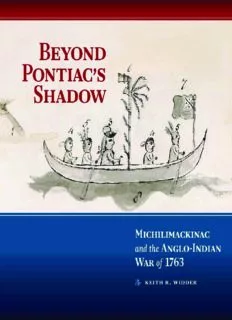
Beyond Pontiac’s Shadow : Michilimackinac and the Anglo-Indian War of 1763 PDF
Preview Beyond Pontiac’s Shadow : Michilimackinac and the Anglo-Indian War of 1763
Beyond Pontiac’s Shadow Beyond Pontiac’s Shadow Michilimackinac Anglo-I ndian and the War 1763 of • keith r. widder MICHIGAN STATE UNIVERSITY PRESS · East Lansing MACKINAC STATE HISTORIC PARKS · Mackinac Island Copyright © 2013 by Keith R. Widder i Th e paper used in this publication meets the minimum requirements of ANSI/ NISO Z39.48-1992 (R 1997) (Permanence of Paper). p Michigan State University Press East Lansing, Michigan 48823-5245 Mackinac State Historic Parks Mackinac Island, MI 49757 Printed and bound in China. 19 18 17 16 15 14 13 1 2 3 4 5 6 7 8 9 10 library of congress cataloging-in-publication data Widder, Keith R. Beyond Pontiac’s shadow : Michilimackinac and the Anglo-Indian War of 1763 / Keith R. Widder. p. cm. Includes bibliographical references and index. ISBN 978-1-60917-382-1 (ebook)—ISBN 978-1-61186-090-0 (cloth : alk. paper) 1. Pontiac’s Conspiracy, 1763–1765. 2. Ojibwa Indians—Wars—Michigan—Fort Michilimackinac (Mackinaw City) 3. Fort Michilimackinac (Mackinaw City, Mich.)—History—18th century. 4. Great Britain—Colonies—America—History— 18th century. I. Title. E83.76.W53 2013 973.2'7—dc23 2012033470 Cover and book design by Charlie Sharp, Sharp Des!gns, Lansing, Michigan Front cover art is a detail from a 1767 drawing by Jonathan Carver. © Th e British Library Board (Add.8950. folio 168). Back cover image: “Habit of an Ottawa an Indian of N America.” Mackinac State Historic Parks Collection (W8.125 H 11.25). G Michigan State University Press is a member of the Green Press Initiative and is committed to developing and encouraging ecologically responsible publishing practices. For more information about the Green Press Initiative and the use of recycled paper in book publishing, please visit www.greenpressinitiative.org. Visit Michigan State University Press at www.msupress.org In Memory of David A. Armour contents ix forewordby Phil Porter xi acknowledgments xvii introduction 3 chapter one. Michilimackinac, 1760: At the Heart of North America 31 chapter two. Michilimackinac, 1761: A French-Canadian, Odawa, and Ojibwe Community 55 chapter three. Detroit, 1760–1761: The British Enter the Pays d’en Haut 75 chapter four. Michilimackinac, 1761: British Troops Take Possession of the Fort and the Posts at La Baye and St. Joseph 95 chapter five. Prelude to War, 1762–1763: Amherst’s Policies, Native Unrest, and the Diplomacy of Thomas Hutchins and James Gorrell 125 chapter six. Michilimackinac on the Brink, Spring 1763 141 chapter seven. Michilimackinac, Summer 1763: Attack, Exile, Diplomacy, Loss, Repatriation 169 chapter eight. Crown Offi cials Respond to Calamity, Late 1763 and Early 1764 189 chapter nine. Prelude to British Reoccupation of Fort Michilimackinac, 1764 203 chapter ten. The British Return to Michilimackinac, 1764–1765 223 epilogue 225 appendix one. Michilimackinac Families 237 appendix two. Dietrich Brehm’s Reports for 1760 and 1761 253 appendix three. Deeds, December 21, 1760 261 notes 299 bibliography 313 index foreword I n 1978, in commemoration of the bicentennial of deep connections with the community. The British regime the American Revolutionary War, Dr. David Ar- injected a new and uncomfortable layer of authority that mour and Keith Widder wrote At the Crossroads, disrupted the relative harmony that existed between their Michilimackinac During the American Revolution. culturally-accommodating French predecessors and the Published by the Mackinac Island State Park Commission, local tribes. Rising tensions, fueled by a broader Indian re- this important work provides a thorough and well-written jection of British authority in North America known as “Pon- examination of that important chapter in Mackinac history tiac’s Rebellion,” exploded in violence at Michilimackinac on when the fur trade and military community of the Straits of June 2, 1763. Mackinac moved from the mainland to Mackinac Island. In Dr. Widder brings decades of research and knowledge to Beyond Pontiac’s Shadow, Michilimackinac and the Anglo-In- the task of sorting out and insightfully telling this complex dian War of 1763, Dr. Widder provides readers with a greater story of the first chapter of British occupation at the Straits context and deeper understanding of the British period at of Mackinac. This includes a 30-year career with Mackinac Michilimackinac by examining the early years of occupation State Historic Parks as a research historian and supervi- and eff ectively revealing the complex and dramatic interplay sor of interpretive programs at Colonial Michilimackinac. of the diverse populations that inhabited the community. Much of the primary source material that Dr. Widder used British fur traders, soldiers and government officials for this project came from the Eugene and Marian Petersen occupied Michilimackinac soon after the conquest of Archaeology and History Center in Mackinaw City. This Canada in 1761. While French soldiers departed, much of the collection, much of which was assembled by Dr. Widder, fur trade society at Michilimackinac remained, including was begun by Dr. Eugene T. Petersen, the first director of French Canadian and métis residents and the neighbor- Mackinac State Historic Parks and deputy director David A. ing bands of Ojibwe and Odawa Indians who had long and Armour. The Mackinac Island State Park Commission, under ix
Description: